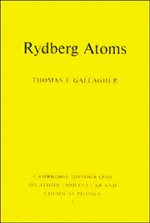Book contents
- Frontmatter
- Contents
- Preface
- 1 Introduction
- 2 Rydberg atom wavefunctions
- 3 Production of Rydberg atoms
- 4 Oscillator strengths and lifetimes
- 5 Black body radiation
- 6 Electric fields
- 7 Pulsed field ionization
- 8 Photoexcitation in electric fields
- 9 Magnetic fields
- 10 Microwave excitation and ionization
- 11 Collisions with neutral atoms and molecules
- 12 Spectral line shifts and broadenings
- 13 Charged particle collisions
- 14 Resonant Rydberg–Rydberg collisions
- 15 Radiative collisions
- 16 Spectroscopy of alkali Rydberg states
- 17 Rf spectroscopy of alkaline earth atoms
- 18 Bound He Rydberg states
- 19 Autoionizing Rydberg states
- 20 Quantum defect theory
- 21 Optical spectra of autoionizing Rydberg states
- 22 Interseries interaction in bound states
- 23 Double Rydberg states
- Index
23 - Double Rydberg states
Published online by Cambridge University Press: 29 September 2009
- Frontmatter
- Contents
- Preface
- 1 Introduction
- 2 Rydberg atom wavefunctions
- 3 Production of Rydberg atoms
- 4 Oscillator strengths and lifetimes
- 5 Black body radiation
- 6 Electric fields
- 7 Pulsed field ionization
- 8 Photoexcitation in electric fields
- 9 Magnetic fields
- 10 Microwave excitation and ionization
- 11 Collisions with neutral atoms and molecules
- 12 Spectral line shifts and broadenings
- 13 Charged particle collisions
- 14 Resonant Rydberg–Rydberg collisions
- 15 Radiative collisions
- 16 Spectroscopy of alkali Rydberg states
- 17 Rf spectroscopy of alkaline earth atoms
- 18 Bound He Rydberg states
- 19 Autoionizing Rydberg states
- 20 Quantum defect theory
- 21 Optical spectra of autoionizing Rydberg states
- 22 Interseries interaction in bound states
- 23 Double Rydberg states
- Index
Summary
The autoionizing two electron states we have considered so far are those which can be represented sensibly by an independent electron picture. For example, an autoionizing Ba 6pnd state is predominantly 6pnd with only small admixtures of other states, and the departures from the independent electron picture can usually be described using perturbation theory or with a small number of interacting channels. In all these cases one of the electrons spends most of its time far from the core, in a coulomb potential, and the deviation of the potential from a coulomb potential occurs only within a small zone around the origin.
In contrast, in highly correlated states the noncoulomb potential seen by the outer electron is not confined to a small region. In most of its orbit the electron does not experience a coulomb potential, and an independent electron description based on nℓn′ℓ′ states becomes nearly useless. There are two ways in which this situation can arise. The first, and most obvious, is that the inner electron's wavefunction becomes nearly as large as that of the outer electron. If we assign the two electrons the quantum numbers niℓi and noℓo, this requirement is met when ni approaches no, which leads to what might be called radial correlation. The sizes of the two electron's orbits are related. The second way the potential seen by the outer electron can have a long range noncoulomb part is if the presence of the outer electron polarizes the inner electron states.
- Type
- Chapter
- Information
- Rydberg Atoms , pp. 466 - 492Publisher: Cambridge University PressPrint publication year: 1994

